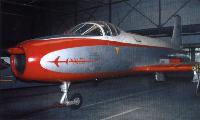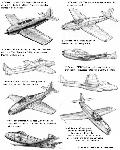
Описание
Страна : Нидерланды
Год : 1951
Двухместный реактивный учебный самолет для углубленной летной подготовки
Fokker S.14 Mach-Trainer
Проект Fokker S.14 Mach-Trainer занял свое место в истории авиации, став первым реактивным самолетом фирмы "Fokker" и первым серийным учебным самолетом на реактивной тяге.
Цельнометаллический низкоплан S.14 оснащался турбореактивным двигателем Rolls-Royce Derwent с носовым воздухозаборником. Сопло находилось в задней части фюзеляжа, за смещенным назад относительно киля стабилизатором. Носовая стойка трехстоечного шасси убиралась вперед по полету в днище фюзеляжа, а главные стойки убирались в ниши крыла. Курсант и инструктор сидели бок о бок в катапультных креслах "Martin-Baker" под широким и выпуклым фонарем кабины, установленным перед крылом.
Летчик-испытатель Гербен Зондерман совершил первый испытательный полет на S.14 19 мая 1951 года. Во втором полете стойка шасси подломилась, и прототип получил повреждения. Однако самолет восстановили и показали на авиасалоне в Париже в июне 1951 года.
Королевские ВВС Нидерландов заказали серию из 20 машин S.14. Первый самолет впервые взлетел 15 января 1955 года. Прототип имел серийный номер K-1 и оснащался двигателем Derwent V. Серийным машинам с двигателями Derwent VIII присвоили серийные номера от LA до L-20.
В 1955 году S.14 с кодом L-4 демонстрировался в США, но 20 октября того же года он разбился в Хейгерстауне, Мэриленд. Самолет L-8 принял участие в авиагонках Лондон - Париж, известных под названием "От арки до арки", так как они начинались у Мраморной арки Лондона и заканчивались у парижской Триумфальной арки. Последние два самолета S.14 были списаны 29 марта 1965 года и сданы в голландские авиамузеи.
В 1953 году на прототипе K-1 двигатель заменили на Rolls-Royce Nene 3 тягой 22,68 кН. 24 октября 1960 года этот самолет получил гражданскую регистрацию PH-XIV и в дальнейшем использовался в голландской национальной лаборатории аэронавтики и космических исследований вплоть до сдачи на слом 4 марта 1966 года.
ТАКТИКО-ТЕХНИЧЕСКИЕ ХАРАКТЕРИСТИКИ
Fokker S.14 Mach-Trainer
Тип: двухместный реактивный учебный самолет для углубленной летной подготовки
Силовая установка: турбореактивный двигатель Rolls-Royce Derwent VIII тягой 15,44 кН
Летные характеристики: макс. скорость 730 км/ч; крейсерская скорость 570 км/ч; практический потолок 11200 м; дальность полета 965 км
Масса: пустого оснащенного 3765 кг; максимальная взлетная 5350 кг
Размеры: размах крыла 12,00 м; длина 13,30 м, высота 4,70 м; площадь крыла 31,80 м2
- Описание
Фотографии
-
Aviation Historian 14 / N.Braas - Machtrainer
The second production Machtrainer, L-2, in the static park at RAF Wethersfield’s Armed Forces Day on May 9, 1959. All 20 production Machtrainers were painted overall silver/grey with a blue nose panel and tapering cheat line and yellow detailing around the intake plus training bands on the fuselage and wings.
-
Air Enthusiast 2003-01 / R.Uijthoven - Twenty-one worldbeaters
The KLu bought 20 S.14s, L-13 awaits another sortie.
-
Air Enthusiast 2003-01 / R.Uijthoven - Twenty-one worldbeaters
Will L-17 come back to life again?
-
Air Enthusiast 2003-01 / R.Uijthoven - Twenty-one worldbeaters
S.14 L-20 during its days of KLu service.
-
Air Enthusiast 2003-01 / R.Uijthoven - Twenty-one worldbeaters
L-20 is preserved in the RNLAF museum at Soesterberg's Kamp Zeist.
-
Air Enthusiast 2003-01 / R.Uijthoven - Twenty-one worldbeaters
S.14s L-13 and L-20 being prepared for flight while a RNLAF Alouette II gets airborne.
Другие самолёты на фотографии: Sud-Est Alouette II / SE.313 / SA.318 / SA.315 Lama - Франция - 1955
-
Air Enthusiast 2003-01 / R.Uijthoven - Twenty-one worldbeaters
Регистрационный номер: PH-XIV [5] PH-XIV inside one of Aviodome's storage hangars at Schiphol-Oost.
-
Aviation Historian 14 / N.Braas - Machtrainer
Регистрационный номер: PH-XIV [5] Opening yet another chapter in the life of the Machtrainer prototype? Sadly not; now on display at the Aviodrome Museum at Lelystad, the aircraft had its wings mounted and was taken outside in 2009 for a spoof April Fool’s Day photographic shoot using the Lelystad-based Fouga Magister’s starting equipment. It is now back in its usual display location inside the museum.
-
Aviation Historian 14 / N.Braas - Machtrainer
The Fokker S.14 prototype, K-1, in its initial bare-metal scheme in 1951, while still fitted with its original Rolls-Royce Derwent 8 engine. On the aircraft’s second flight the undercarriage jammed halfway down, test pilot Gerben Sonderman having to perform negative-g manoeuvres to force it up before making a skilful belly-landing.
-
Aviation Historian 14 / N.Braas - Machtrainer
Despite its short, stubby wings, gaping air intake and large, broad canopy, the Machtrainer was nevertheless an attractive aircraft, especially when on the ground, its wide-track undercarriage giving the trainer a purposeful stance. The prototype S.14, K-1, is seen here in November 1951, still fitted with its original Derwent engine.
-
Aviation Historian 14 / N.Braas - Machtrainer
Dubbed the 'Flying Plank', the S.14 was nevertheless of pleasing appearance.
Conceived as a jet trainer from the outset - the first such aircraft not to be merely a development of a pre-existing fighter design - the S.14 was designed to be able to be spun, incorporating a fin placed well ahead of the tailplane. The prototype, still powered by a Derwent, is seen here during one of its many pre-Nene trial flights. -
Aviation Historian 14 / N.Braas - Machtrainer
The hardworking prototype fitted with an experimental metal canopy for pressure-measurement trials. The long nose-mounted probe was fitted when the Derwent was replaced with the Nene engine in 1953.
-
Air Enthusiast 2003-01 / R.Uijthoven - Twenty-one worldbeaters
With the S.11 Instructor (right), Fokker was able to offer air forces a package of primary and jet conversion trainers. The S.11 - and the tri-gear S.12 - was a production success, including license manufacture in Brazil and Italy.
Другие самолёты на фотографии: Fokker S.11 Instructor - Нидерланды - 1947
-
Air Enthusiast 2003-01 / R.Uijthoven - Twenty-one worldbeaters
The prototype quickly adopted pseudo-KLu colours with the serial 'K-1'.
-
Aviation Historian 14 / N.Braas - Machtrainer
The revised rear fuselage of the Nene-powered Machtrainer incorporating the new engine’s larger jetpipe. Note also the extended three-section lattice-type airbrakes which replaced the originals, which were of slab type, to cure buffeting problems The revised slotted airbrakes were fitted to production examples.
-
Aviation Historian 14 / N.Braas - Machtrainer
Only one production batch of 20 Machtrainers was built, all powered by the Derwent engine, the logic being that KLu pilots would be converting to Derwent-powered Meteors, making a Nene-powered S.14 variant superfluous to requirements.
-
Jane's All the World Aircraft 1980 / Encyclopedia of Aviation - Aircraft A-Z - v3
Fokker S.14 Mach-Trainers.
-
Aviation Historian 14 / N.Braas - Machtrainer
Ill-fated Machtrainer L-7 is refuelled at Twenthe. The horse emblem on the fin - Het Twentse Ros - was a standard marking for aircraft based at Twenthe. Sadly, L-7 went on to become the only Machtrainer to be involved in a fatal accident, when its two occupants were killed during a low-level training sortie over Zeeland in May 1964.
-
Air Enthusiast 2003-01 / R.Uijthoven - Twenty-one worldbeaters
L-3 proving that while the Machtrainer was underpowered, it was no slouch.
-
Мировая Авиация 137
На снимке второй или третий серийный экземпляр Mach-Trainer демонстрирует характерные для этого типа простые, но функциональные обводы.
-
Air Enthusiast 2003-01 / R.Uijthoven - Twenty-one worldbeaters
S.14s L-2 and L-3 at altitude.
-
Aviation Historian 14 / N.Braas - Machtrainer
Регистрационный номер: PH-XIV [5] The prototype, registered PH-XIV, on display in the distinctive Aviodome museum at Schiphol in September 1971. Having provided sterling service as a trials aircraft, the S.14 prototype was retired by Fokker in 1956, only to be made airworthy again and used as a test article by the Dutch scientific organisation NLL/NLR during 1960-66.
-
Air Enthusiast 2003-01 / R.Uijthoven - Twenty-one worldbeaters
Регистрационный номер: PH-XIV [5] S.14 PH-XIV spent several years with the NLL, it is illustrated at Schiphol-Oost.
-
Aviation Historian 14 / N.Braas - Machtrainer
The prototype, K-1, after the fitting of the Nene engine in late 1953, and sporting the Fokker-designed 20mm cannon belly-mounted gunpack. Originally ordered for all 20 KLu Machtrainers, the gunpack was ultimately cancelled, the sole example being fitted and flown only on K-1.
-
Aviation Historian 14 / N.Braas - Machtrainer
Prince Bernhard of The Netherlands climbs aboard the Machtrainer prototype in November 1953, after it had been fitted with a Rolls-Royce Nene engine. About to join the prince is Fokker test pilot Gerben Sonderman, who made the type’s first flight in 1951.
-
Aviation Historian 14 / N.Braas - Machtrainer
Dutch air force pilot Joop Willemsen accrued almost 1,000 flying hours in the S.14 as an instructor at Ypenburg, where non-operational pilots gained jet experience and Dutch Navy Hawker Sea Hawk pilots took their instrument ratings.
-
Air Enthusiast 2003-01 / R.Uijthoven - Twenty-one worldbeaters
Регистрационный номер: PH-XIV [5] View of the instrument panel of PH-XIV and a part of the roomy cockpit with its ejection seats.
-
Aviation Historian 14 / N.Braas - Machtrainer
The Machtrainer "office" Derwent-powered production variant
-
Air Enthusiast 2003-01 / R.Uijthoven - Twenty-one worldbeaters
Machtrainer L-18 was displayed at Ypenburg until its demise in 1992.
-
Aviation Historian 14 / N.Braas - Machtrainer
Fokker’s accident investigation committee surveys the wreckage of L-4 in the USA in 1955.
-
Aviation Historian 18 / N.Braas - Unlucky 13: Fokker's forgotten twin trainer
Construction of the S.13 prototype at Amsterdam-Noord in 1949. In the background are one of the two S.13 mock-ups (right) and a mock-up of the forward fuselage and centre section of the S.14 Machtrainer, which would make its first flight in May 1951.
Другие самолёты на фотографии: Fokker S.13 Universal Trainer - Нидерланды - 1949
-
Aviation Historian 14 / N.Braas - Machtrainer
ORIGINALLY CREATED BY Serbian aviation illustrator and artist Srecko Bradic for the definitive book on the Fokker S.14 by Nico Braas and Willem Vredeling, the pencil sketches were not included in the book and are published here for the first time. Also included are sketches of two proposed S.14 developments which were ultimately never built. Had the S.14 been ordered for the USAF and US Navy (and licence-built by Fairchild), it would have been fitted with American avionics and instruments, an American jet engine and a singlepiece canopy. The ventral airbrake would have been removed and the US Navy version would have been fitted with an arrester hook and folding wings. It was, however, not to be.
- Фотографии
































